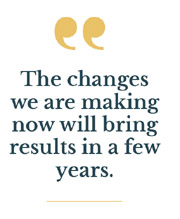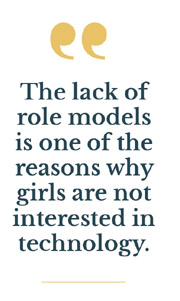Aj Ty v IT is already in its 11th year of supporting girls and women in IT and related subjects. What are the biggest differences between the situation in Slovakia in 2012 and today?
When we started in 2012, the most common question was: “Why are you doing this? We don’t see a problem with girls and women in STEM”. So there was a lot of discussing and explaining and yes, our idea and activities were not accepted and understood every time.
Today, companies are well aware of the huge problem we have in this area. That is a big change.
What is harder to explain is that we need to take an active approach to solving this problem. Our school system is still far from ready for any meaningful changes.
How does Slovakia compare to other countries in the region when it comes to the number of female IT students or the number of women working in IT and in leadership positions?
As far as female IT students are concerned, Slovakia currently has about 15% of female students, while the European average is at 17%. The situation is the same for women working in ICT positions.
Slovakia is making small and constant progress to improve the situation, but we have to be aware that this is a long-term process. The changes we are making now will bring results in a few years.
 Which social and gender stereotypes persist and which are disappearing?
Which social and gender stereotypes persist and which are disappearing?
I think one of the biggest stereotypes about the ability of women to work as IT specialists is slowly being broken down. And I’m glad about that.
A persisting stereotype concerns the time availability and determination of women to spend long hours coding and solving problems. Employers often see the ideal employee as a man who spends hours and hours on the job. The understanding that it is not the number of hours but the creative approach that delivers the solution is slow to dawn. But this stereotype is typical of the IT sector in general; it is not specifically linked to women.
What do you think plays the strongest role in this regard - the upbringing in families, the education system, or the unwritten rules of the workplace?
They are all important. Family upbringing creates our identity and impacts how we behave in life. If well brought up children are supported by creative and supportive approaches in school, the results are very promising and positive. On the contrary, an imbalance in families, unrealistic demands and expectations from the parents, and, finally, a school system where individual personalities are not respected, can create a disaster in the mind of the child.
What are the critical points when most girls or young women lose interest in pursuing an education or career in tech, or simply resign, when faced with the existing obstacles?
Underestimation. Lack of support. Lack of confidence. I would emphasize these factors when discussing why women leave IT. They just don’t want to fight all the time. You still have to prove to your colleagues, to your boss, that you are doing a good job. Women’s position is weaker compared to men’s career opportunities. They have to take more steps to get to the top. And that can be discouraging.
 As far as education is concerned, girls just don’t get enough support from our system to push them into technical fields. If I were to oversimplify - nobody has shown or told them that we need them and that they can do it. When you are 16 or 18 years old, you just need that support and guidance.
As far as education is concerned, girls just don’t get enough support from our system to push them into technical fields. If I were to oversimplify - nobody has shown or told them that we need them and that they can do it. When you are 16 or 18 years old, you just need that support and guidance.
What are the most inspiring examples of women in Slovakia who were able to break these stereotypes in the tech or IT industry?
We have a certain number of ‘rising stars’, young women who are on their way to creating wonderful tech projects with huge impact. But we also have a lot of women working in different technical positions where they are not particularly visible. They are the backbone of the support system of role models for girls, because they are closer to them and can support them on a daily basis.
The second edition of the Slovak Women in Tech conference we organized in Bratislava on October 12 was a good opportunity to see wonderful examples of women at the beginning of their careers, but also of those at the top. I’m happy that we can support the female tech ecosystem through this event, which is much needed in Slovakia.
Do you feel they receive enough media attention and are able to reach and inspire girls in Slovakia?
The lack of role models is one of the reasons why girls are not interested in technology. Women in the media are often portrayed in subordinate roles and success is more often attributed to men. It is very difficult to discuss IT careers with girls if they have never met or read about other women in technology. They have no one to follow. They just can’t imagine that working in technology could be a possibility for them.
 To what extent is this topic interesting for businesses and how would you describe your cooperation with partners from the business world over time?
To what extent is this topic interesting for businesses and how would you describe your cooperation with partners from the business world over time?
It was very difficult at the beginning, but now our cooperation is very open and respectful. Our cooperation is based on mutual exchange related to methodology, different educational approaches, our regional presence and, of course, their needs and how we can help them.
We have a long-term relationship where companies can see in detail what we are doing. And most importantly, they see our results, which helps build trust.
What are the most meaningful steps companies can take to engage and support more women in their tech or IT departments?
Take it seriously; not just in a rhetorical way. Diversity and inclusion have become buzzwords on corporate websites and in presentations. But often that is where the initiative starts and ends.
We have great examples of companies that are really working hard in this area. And we can also see the results of their activities in a healthy working environment with gender diverse teams.
Do you feel that this issue is also becoming a political priority?
It’s moving slowly and I wouldn’t see it as a political priority (at least not today).
What policy changes could have the biggest positive impact in your opinion?
Maybe if women had the same representation as men in our political system.
***
The organization, founded by Petra Kotuliaková in 2012, is a key player in women’s IT education in Slovakia. Aj Ty v IT actively supports, educates, and empowers girls from the age of eight to adult women in the field of technology. For 11 years, the organization has trained more than 38 000 female participants in various IT topics and increased the number of female students at IT faculties from 3% to 17%.
Petra Kotuliaková, Founder and CEO, Aj Ty v IT



Follow us